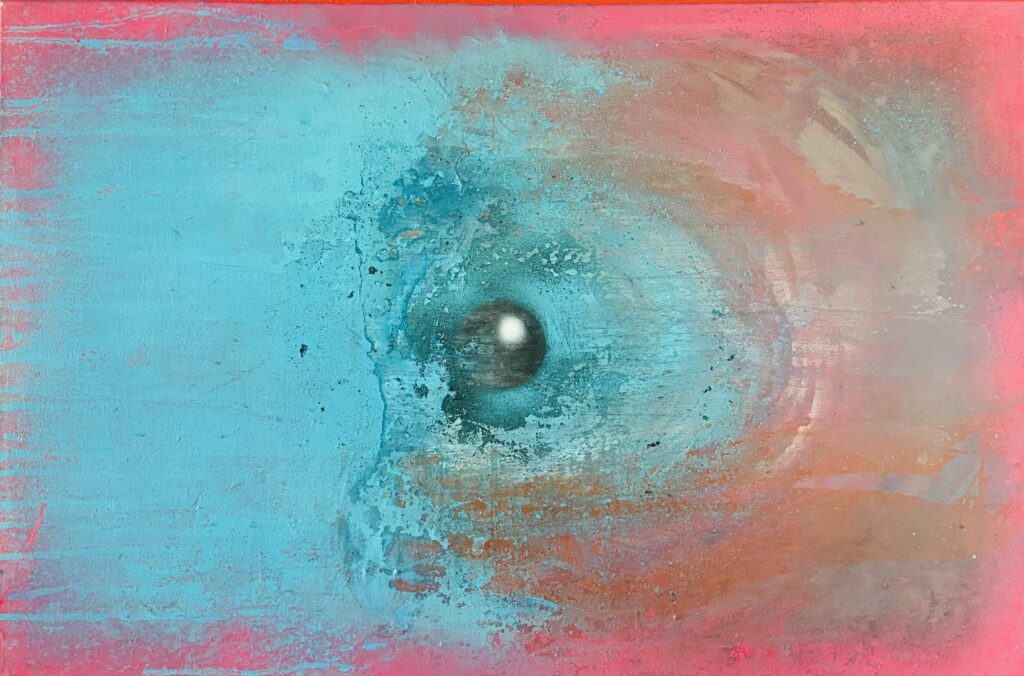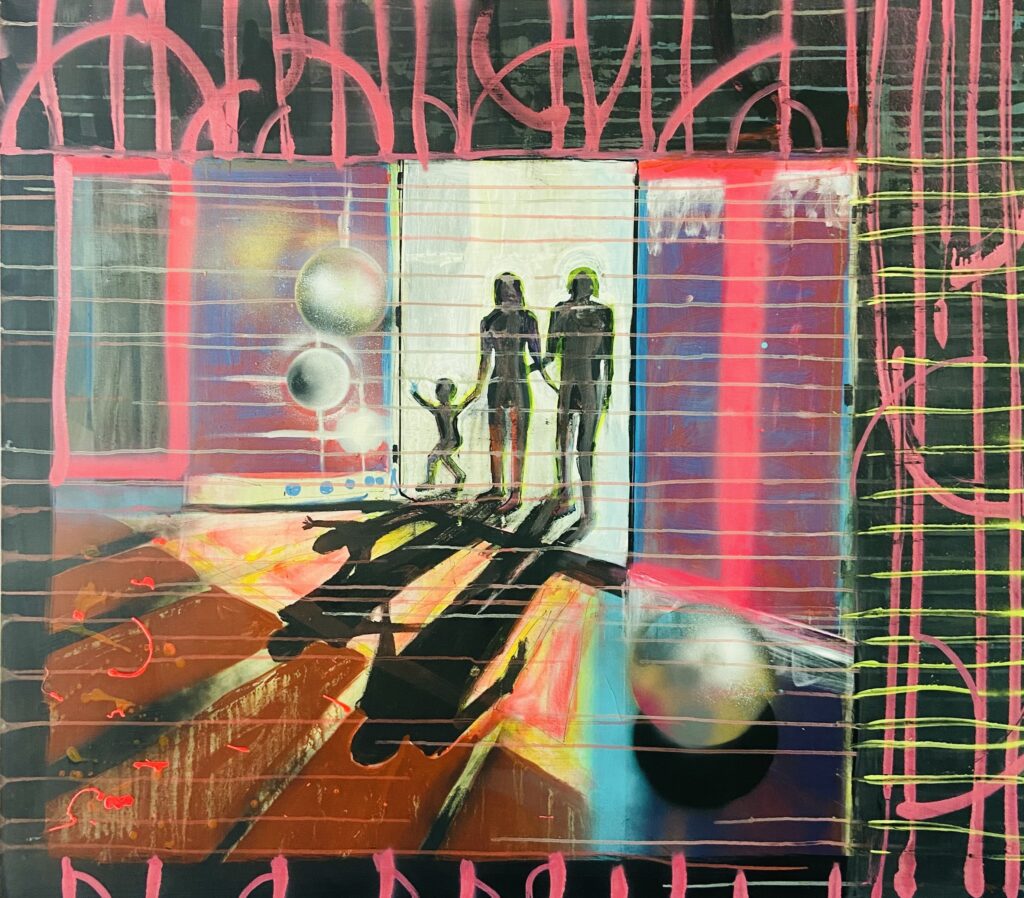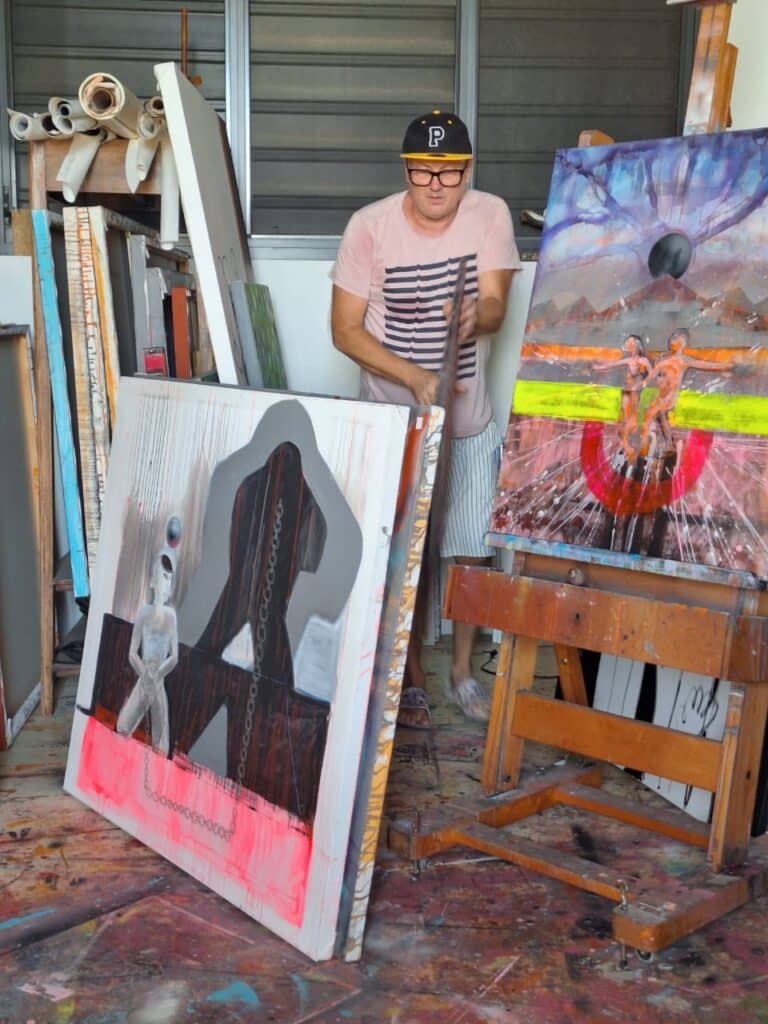Paul J. Riley’s artistic journey is a compelling narrative of transformation and rediscovery.
Originally trained in industrial design, Riley’s early career saw him creating innovative products for renowned brands like Haagen Dazs and Vivienne Westwood. However, a return to his artistic roots led him to embrace painting, where he combines his technical precision with a vibrant, free-spirited approach.
Now residing in Grenada, Riley draws profound inspiration from the stunning landscapes of the Caribbean and his native Wales. His work, characterised by its dynamic compositions and rich, emotive themes, explores the interconnectedness of nature, personal resilience and the search for a higher power. Riley’s art is a testament to his enduring creativity and the powerful influence of his diverse experiences…

Your journey as an artist has been truly fascinating, from your beginnings in industrial design to your rediscovery of painting after a hiatus. Can you walk us through the pivotal moments that shaped your artistic career?
At school, I was always the kid winning the art competitions, though I never actually studied art due to curriculum clashes. I did engineering design because I liked the technical drawing and physical work with metal. Career advice was patchy back then, and for some reason, I ended up doing three science “A” levels, which I struggled with, and a first year of a degree in polymer chemistry. This included a day release in industrial design, where the lecturer let me straight onto the design BA degree course after one student left for medical reasons. From there, I went to the Royal College of Art.
After my education, I formed a company and worked for eight years, during which we had a factory in Newcastle making plastic spoons for Haagen Dazs, as well as consultancy work until my first son was due to be born.
Your diverse background includes designing products for renowned brands like Haagen Dazs and Vivienne Westwood. How has your experience in industrial design influenced your approach to painting?
I always approach a canvas with a plan, which in design, we would call a brief. Although I’m not formally trained as a painter, I’m very obsessive about composition and line. These days, however, I usually stay as free as possible around the plan and let my second son mark the canvas if he’s present. Sometimes, this creates a new magic or added element.
Many artists find inspiration in their surroundings. How have the landscapes of Wales and Grenada influenced your artistic style and themes?
The sky and shadows here are higher and bigger, like an “L.A.” light at 7:00 am. I had spent over 20 years in London without seeing the horizon. Initially, I painted outrageous versions of the walking tree I can see from my window, which is like a cathedral full of iguanas, and the curve of the hillside opposite, which resembles a woman’s hips or part of an infinity symbol. The nothingness of the horizon reignited a spark in me, the feeling that nothing is forever.
I had some health challenges (heart attack, new hips, some medium-level addictions, and type 2 diabetes) and wanted to leave something behind for my sons. I had previously been working on a music project (Paul J Riley), but it gradually morphed into visual art in the new surroundings. My inspirational parents sent me paint as a hint to ease off the bar hopping, which gradually pulled me away from drinking and lit a fire under me for visual art.
Your artwork is described as exploring the energy that connects us and the possibility of a higher power. Could you delve deeper into the concepts and emotions behind your work?
Having had a heart attack, I have seen the light on the other side that people often describe. Here, we get what the Italians call chiaroscuro daily—those moments where you think there must be a god. I have a level of telepathy with my partner here, which inspires some of my work.



In addition to your art, you’ve also pursued a music career under the name “Paul J. Riley.” How do you see music and visual art intersecting in your creative process?
The music visits periodically. The last time, around 2015-17, when I sat down and listened to it, I realised it was telling me to get out there and love someone again. So, one art form bounces off the other. I lived in London for 30 years, and that produced a darker introspection in the painting and a useful biographical one in the music.
Building your own house in Grenada must have been an incredible journey. How has living in Grenada impacted your creative mindset and artistic expression?
Yes, if I had known how much work and money it would take, I probably wouldn’t have done it. We did it in small increments over about a year and a half. My first son reminded me that I had been meaning to do it for more than ten years, and I’m glad we did as it changed everything. We carved our names in a gum tree there. Meeting my life partner here, who also dreamed of living by the sea, made me realise that the time is now. Life is not a dress rehearsal, as someone once said. I no longer procrastinate. The landscape of Mongolia is mind-boggling, and I have a whole set of paintings planned from there.
Your art seems deeply personal, reflecting your experiences and struggles. How do you navigate the balance between vulnerability and privacy in your work?
I’m not sure it’s possible. I’ve never worked for anyone else, so I never developed a dividing line between home and work. I’m on a journey to inner space, and attempting to feed the algorithm on Instagram is the closest I’ve ever come to having a regular job. But I generally treat it like a portfolio, so it has a positive creative function in that it helps me know where I’m headed creatively. I don’t generally post pictures of my son looking at the camera, and my partner usually declines to be featured.
You’ve exhibited your work in various prestigious venues, from Art Basel to Art Innsbruck. What have been some of the most memorable moments of your career so far?
It’s fairly early days in this incarnation as a visual artist. Seeing lots of school kids picking my art out of a room of paintings at the national museum here in Grenada this year was memorable. When I was in college, the Victoria and Albert Museum took one of my design drawings for their permanent collection. At the time, it didn’t seem significant, but now I wish I had paid more attention to the career message! I’m about to do a solo show from April 24-30 at J/M Gallery in Portobello Road, London, which is quite exciting. There is a Geest boat with 56 paintings on its way to the UK as I write this.

Can you share some insights into your creative process, from the initial spark of an idea to the finished artwork?
I have a sketchbook next to me at breakfast, and I generally note down four or five ideas as the sun comes up before my brain jumps onto mundane thoughts. I run my second son to playgroup, then work on three or four paintings for an hour or two at the same time. It’s very hot, so there’s a lot of sweat and some self-criticism, but ultimately, it’s a bit like surfing or meditation. The paint dries quickly but isn’t ready for another layer for a few hours. Usually, my “12-cylinder painting brain” will get burned out, and I’ll switch to “8-cylinder practicalities” like making stretchers or whatever.
Your use of acrylic and car paint on canvas and wood panels is quite unique. What draws you to these particular materials and techniques?
The fact that car paint is available on a car-obsessed island and uses different thinners than acrylic (which is hard to get at good quality and always with a wait) means I can remove one without touching the other. The wood is usually recycled from shipping boxes, and often canvas is sewn together from smaller pieces as the idea grows (see “All That Glistens” or “The Penitent”).
Parenthood is often a significant source of inspiration for artists. How has being a parent influenced your artwork and perspective on life?
I watch my son’s carefree approach to mark-making and life itself and attempt to keep that with me as I work. We usually go swimming when he comes home around 3:30. I’m painting firstly for myself to keep me on the outward journey, but secondly to help him when I’m no longer on planet Earth.
The theme of resilience shines through your art, despite your struggles with self-criticism and addiction. How has art helped you navigate these challenges?
Art has definitely saved me, and life has given me more things to paint than I will have time to paint. I am lucky to be able to reinvent myself after a heart attack in 2011.
Your work has been described as visually stunning with a unique Caribbean twist. How do you balance your Welsh roots with your life in Grenada in your artistic style?
I have the darkness you get from a Welsh winter, with the hope of spring and the amazing shadows of a 7:00 am light. They both seem to go together. There is usually some sort of orb replacing the sun or moon, representing my fear and hope for whatever is going on in the painting.
Exhibiting at the Grenada National Museum must have been a special moment. Can you share your thoughts on being part of such a significant event celebrating Grenada’s Golden Jubilee?
It was fabulous to be included as an outsider and to see the reactions of the kids to a less than traditional style of art. It was also the longest exhibition by far.

Your Instagram reels give us a glimpse into your creative process. How do you use social media to connect with your audience and share your art?
It’s very useful to ask yourself, “What am I trying to communicate?” Otherwise, I’m very isolated living in this part of the world. Generally, I use it as a portfolio (the stills), and the reels can be a bit annoying as they distract from the process if I have to film them. But I now have someone who will come out and shoot for me!
Looking back on your career, what advice would you give to aspiring artists who are just starting on their creative journey?
“Keep on keeping on.” I’ve tended to get distracted after the eight-year mark in other creative fields, so I would say just keep going!
Your paintings “How It Began” and “Experimental Landscape” were featured at the Grenada National Museum exhibition “Infinite Futures.” What inspired these particular pieces, and what message do you hope viewers take away from them?
I replaced the sun with a giant blue marble in “How It Began” and a steel ball bearing in “Experimental Landscape.” They can be enjoyed on any level, but to me, they comment on the imminent threat of the world we live in, whether by virus, nature, or war, and also the passage of time, with figures passing blissfully through unaware of world events as we often are here.
The energy of nature seems to be a recurring theme in your work. How do you capture that essence on canvas, and what emotions do you hope to evoke in your audience?
I paint with velocity, working on five or six paintings at once, and tend to ignore colour theory! Trees are like cities with whole communities interdependent. The colours are so big they bleed from the edges, and the painting changes as the sun moves over.
There are oak trees in my parents’ valley as old as the Domesday Book, and the place where I built my house feels like it has energy lines culminating in a giant banyan at the end of the garden. When I saw the piece of land, I said “yes” immediately.
Your art has evolved significantly since your days at the Royal College of Art. How do you see your style and themes developing in the future?
I have a young mind, I’m told, but backed up with a lot of mistakes and oubliettes: “colourful with a hint of danger.”
Our readers love to travel. What destination is at the top of your bucket list?
Grenada, of course, but for what it doesn’t have rather than what it does. It’s a slower pace of life with time to think, a great place to write, paint, and compose.

Where can people follow you and find out more about your career?
Yes, @pjrileyart has my newest work, and @riley_archive has the older work. Also, www.pjriley.com.
Paul J. Riley’s story is a testament to the transformative power of art and the enduring spirit of creativity. His journey from industrial design to painting and the unique blend of technical skill and emotive expression in his work, offer a fascinating glimpse into the mind of a true artist. As Riley continues to explore new horizons and push the boundaries of his craft, his art remains a vivid reflection of his life’s experiences and the beauty he finds in the world around him.
To discover more inspiring stories of creativity, resilience, and artistic innovation, visit House of Coco. Immerse yourself in the journeys of artists from around the globe, each with their unique tales and visions that will leave you inspired and eager for more.





Comments are closed.